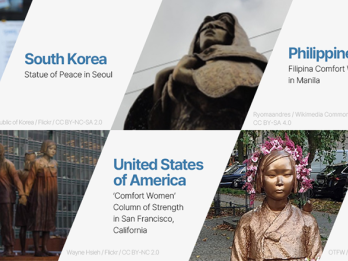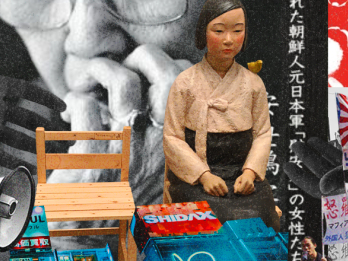
To mark the 2025 International Memorial Day for the Japanese Military "Comfort Women," webzine KYEOL reflects on survivors' testimonies and the global efforts to preserve their memories. The project “My Mother Is More Than A Comfort Woman” tells the stories of the survivors through their daughters and granddaughters, shedding light on silenced histories. The Contested Histories Initiative emphasizes how monuments and memorials act as battlegrounds for memory, challenging historical silence. American artist Rose Pritchett’s quilt works, featuring survivors' words, highlight how art and education can transmit memory. Emerging scholarship underscores the violation of children's human rights, calling for renewed attention in international justice. We invite you to join this collective act of remembrance—one that reminds us of our responsibility to carry forward voices that are fading, and to transform memory into a shared historical commitment.
1. My Mother Is More Than A Comfort Woman: A Storybook of the Lolas from Their Daughters’ Perspectives
2. Art as a Messenger of Women’s Stories: Interview with Rose Camastro-Prichett about her “Comfort Women” Project
3. Tackling Contested Histories for a Deeper Understanding of the Past and Present
4. Educating Difficult Histories and the Case of the “Comfort Women”
5. “Comfort Girls”: The Forgotten Tragedy of Child Exploitation
Interview with Dr. Paula O’Donohoe, Program Director of the Contested Histories Initiative (1)
![[Photo 1] The banner image of the Contested Histories Initiative website (Credit: Contested Histories Initiative). [Photo 1] The banner image of the Contested Histories Initiative website (Credit: Contested Histories Initiative).](https://kyeol.kr/sites/default/files/image1.png)
We live among monuments, often without noticing them. We pass by statues of historical figures on our way to work or school, use street names honoring figures of the past to find directions, and occasionally pause to wonder why a certain bronze plaque in a park square is there. They are not just relics of the past, but they speak to who and what society has chosen to remember. Sometimes, they spark contestation, including debate, protest, and even removal. The iconic Statue of Peace in front of the Japanese embassy in Seoul stands not only as a tribute to the victims but also as a stage for ongoing protest, by both activists seeking justice and denialists denying the history. In Manila, a statue commemorating Filipino “Comfort Women” mysteriously disappeared without explanation shortly after its installation. These memorials compel us to ask: What stories are they trying to tell? Who decides which memories are preserved? And why do such questions provoke such intense and passionate contestation?
In this interview, Kyeol speaks with Paula O’Donohoe, Program Director of the Contested Histories Initiatives (CHI), to discuss why monuments matter, how historical disputes unfold in public spaces, and what it means to engage with difficult histories, especially when they remain unresolved.
![[Photo 2] Dr. Paula O’Donohoe, Program Director of the Contested Histories Initiative (Courtesy of Paula O’Donohoe). [Photo 2] Dr. Paula O’Donohoe, Program Director of the Contested Histories Initiative (Courtesy of Paula O’Donohoe).](https://kyeol.kr/sites/default/files/image2_0.jpeg)
Mapping Memory: The Birth and Mission of the Contested Histories Initiative
Kyeol : Thank you for speaking with Kyeol. Please introduce yourself.
🧶 Paula O’Donohoe : My name is Paula O’Donohoe, the Program Director at the Contested Histories Initiative (CHI), and I also work as a project manager and research coordinator for EuroClio. The Contested Histories Initiative is one of the projects in which I am involved.
Kyeol : What is the Contested Histories Initiative and who is on the team?
🧶 Paula O’Donohoe : The Contested Histories Initiative (CHI) started in 2016 as a long-term partnership between EuroClio, the European Association of History Educators, and the Institute for Historical Justice and Reconciliation (IHJR). EuroClio is a member-based organization and the members are mainly history teachers’ associations from different regions and countries. We are mainly based in Europe, but we also take on projects in other parts of the world when opportunities come up. We collaborate with people across North and Latin America, Africa, and Asia.
CHI was created to look at contestations over statues, monuments, memorials, street names, buildings, and other physical representations of historical legacies in public spaces. It’s actually our most global project. We track these types of debates around the world, and right now, our database includes 610 cases across 132 countries.
We are a small core team, but we’ve got a great group of research interns and professional volunteers who help with the case studies. Most of the interns are university students who join through our partnerships with schools. We also have an academic committee that reviews the studies, helps identify new cases, and sometimes represents us at conferences and events.
![[Photo 3] EuroClio Annual Conference 2025, Bratislava (Credit: Contested Histories Initiative) [Photo 3] EuroClio Annual Conference 2025, Bratislava (Credit: Contested Histories Initiative)](https://kyeol.kr/sites/default/files/EuroClio.jpeg)
Kyeol : How did the organization get started, exactly?
🧶 Paula O’Donohoe : CHI was launched by the Institute of Historical Justice and Reconciliation in 2016, right after the “Rhodes Must Fall Movement” began in Cape Town and at Oxford in 2015. IHJR had already been working on contested histories and difficult legacies, and they were invited into discussions about what should happen after a statue like Rhodes is removed. The idea was that removing a statue doesn’t erase the conflict around history. So they started mapping cases of contested public memory around the world. This map is available for free download from our website.[1]
![[Photo 3] The Cecil Rhodes statue on Oriel College, in Oxford, UK, in 2023 (Credit: Set in Stone Project, Wikimedia Commons) [Photo 4] The Cecil Rhodes statue on Oriel College, in Oxford, UK, in 2023 (Credit: Set in Stone Project, Wikimedia Commons)](https://kyeol.kr/sites/default/files/image3_0.jpeg)
That’s how CHI was born. It started as an IHJR initiative, and in 2018 became a joint effort with EuroClio. To provide some background, EuroClio was founded in 1992 following the fall of the Berlin Wall, with a focus on how to teach Europe’s recent history. It’s an independent NGO, and now co-directs CHI alongside IHJR.
Why Monuments Matter: Understanding the Politics of Public Memory
Kyeol : According to the CHI website, the organization focuses on physical monuments, such as statues, street names, and other historical legacies in public spaces. Why are those such important topics to focus on?
🧶 Paula O’Donohoe : The conversation really picked up around the Rhodes statue at Oxford and in Cape Town. But more broadly, monuments matter because they are very physical reminders of the past, and at the same time, they are so familiar that we often stop noticing them. They are just part of the urban landscape. So it’s important to engage more critically with the spaces that we move through every day, and recognize the layers of history embedded within them.
Also, monuments can serve as powerful educational tools. You can see them and touch them. That physical presence helps make history feel more present in our daily life, especially for students.
Kyeol : Could you talk about the relevance of these historical disputes today? Some people say that how we view the past changes depending on current events or politics. How does CHI think about the relationship between historical legacies and present-day interpretations?
🧶 Paula O’Donohoe : That’s a really important point. We actually saw a major spike in cases during the pandemic, especially around statues connected to colonialism, slavery, and other controversial legacies. That’s when we really started talking about what makes something a “contested history.”
What we’ve found is that these disputes often involve historical figures or events that can trigger strong emotional responses. But whether or not something becomes contested usually depends on the political and social context. For example, lots of Columbus statues became highly contested during the Black Lives Matter protests in 2020, but others in similar settings didn’t face any controversy at all. It really depends on what’s happening politically, socially, and even economically.
![[Photo 4] An empty plinth of the statue of Edward Colston in Bristol, UK. (Credit: Neil Owen, 2021, Geograph Britain and Ireland, Wikimedia Commons). [Photo 4] An empty plinth of the statue of Edward Colston in Bristol, UK. (Credit: Neil Owen, 2021, Geograph Britain and Ireland, Wikimedia Commons).*](https://kyeol.kr/sites/default/files/image4.jpg)
* In June 2020, at the height of the global Black Lives Matter protests, a group of demonstrators pulled down the statue of Edward Colston from its plinth and threw it into Bristol Harbour in protest of his involvement in the Atlantic slave trade and colonialism. A few months later, in September 2020, the statue was recovered and displayed as the centerpiece of an exhibition titled ‘The Colston Statue: What Next? at the M Shed Museum in Bristol. For more details, see the CHI’s case study on the Colston statue: https://contestedhistories.org/wp-content/uploads/UK_-Edward-Colston-Statue-in-Bristol-Published-2.pdf.
We often see these moments of contestation arise during times of unrest, when people are pushing back against dominant narratives that have ignored or marginalized certain communities. Taking down a statue isn’t just about that one figure. It becomes part of a bigger conversation about national identity and who gets represented in the public space.
In this sense, the public space turns into a kind of battleground for competing narratives. That’s why, for each case in our database, we conduct in-depth research into the surrounding context about what was happening politically, socially, and economically when the controversy arose. That context is essential to understanding why these legacies become flashpoints at particular moments.
Contested Legacies, Collaborative Research: The Case Study Process at CHI
Kyeol : That’s a good point to transition into your case studies project. Could you explain how they work? What do they include, who writes them, and how are they reviewed?
🧶 Paula O’Donohoe : Sure. Most of our researchers are university students or professionals from various fields. They follow a shared template when writing the case studies, which helps us keep things consistent.
Each case includes the historical background of the site, such as when it was built, who funded it, where it’s located, and why, and what it symbolizes. We also look at the design and examine who created it, whether there are cultural or ethnographic factors involved, and then go into the contestation itself: why the site became controversial, who initiated the debate, how the dispute evolved over time, and what narratives emerged. Finally, we cover what remedy has been chosen.
Once a draft is done, our internal team reviews it first. Then it’s sent to external experts, either on the content or on the region, for feedback. The researcher revises the draft based on the reviews, and the core team makes the final decision on whether or not to publish. It can take several rounds of revisions, and it’s a very collaborative process.
We try hard to make sure that all different views are represented and that the writing stays balanced. That doesn’t mean giving a space to hate speech or discriminatory views. On the contrary, part of the review process involves ensuring we don’t reproduce harmful or biased language, especially since many of these cases involve marginalized communities.
Kyeol : Who is the audience for CHI’s research? How has your work been received, in your view? Have you seen any changes, impacts, or responses?
🧶 Paula O’Donohoe : Our primary audience is university professors, as the language in our materials tends to be somewhat academic and formal. However, we also reach history teachers at the high schools and secondary levels, many of whom use our case studies to explore contested issues with their students. Policymakers are also showing growing interest. In fact, we’ve been contacted by several city councils that weren’t sure how to handle contested heritage in their areas.
We’ve also received attention from policymakers in intergovernmental organizations, such as the International Bar Association and the High Commissioner on National Minorities.
One of the most unexpected audiences has been people interested in dark tourism. As interest in dark tourism grows, many of our case studies have been featured on travel websites like TripAdvisor as recommended reading for tourists planning visits to historical sites. We’ve noticed an increase in traffic from these platforms, and we even receive emails from tourists asking for more information about specific sites. It’s been a surprising and interesting aspect of our project’s reach.
As a sidenote, all of our case studies are open to the public. Everything we publish is under a Creative Commons license, which means they are freely accessible and adaptable. While our case studies have an academic tone, we’re also developing more accessible materials through our Monumental Challenges toolkit, which includes lesson plans that are educational and easy to use.
Is the 'Comfort Women' Controversy Resolved? Exploring Remedies for Contested Monuments
Kyeol : Your website labels case studies as “ongoing” or “resolved.” How do you decide which is ongoing while the other is not? When do you consider a case “resolved”?
🧶 Paula O’Donohoe : We consider a case resolved when a remedy has been applied. Through our research, we’ve identified three main types of remedies commonly used to address contested monuments or sites: resignification, removal, and (re)naming.
Resignification involves adding new context to a monument without removing it. One common method is placarding. A notable example is the statue of Jan Pieterszoon Coen in Hoorn, the Netherlands. This monument has been disputed for failing to acknowledge the legacies of slavery and colonialism. In response, a contextualizing plaque was added to explain the historical significance of the statue and why it has become a point of contention.
![[Photo 5] The statue of Jan Pieterszoon Coen in Hoorn, the Netherlands (Credit: Gerard Dukker, 1987, Rijksdienst voor het Cultureel Erfgoed, Wikimedia Commons).* [Photo 5] The statue of Jan Pieterszoon Coen in Hoorn, the Netherlands (Credit: Gerard Dukker, 1987, Rijksdienst voor het Cultureel Erfgoed, Wikimedia Commons).*](https://kyeol.kr/sites/default/files/image5.jpeg)
* This statue has been the subject of controversy since it was erected in 1893 in Hoorn, Coen’s hometown and has been vandalized multiple times due to Coen’s role in the Dutch colonial enterprise in Southeast Asia. In 2010, a citizens’ initiative publicly criticized the statue, leading to the addition of a contextualizing plaque in 2012. The statue drew attention again in 2020 during the George Floyd protests. For more details, see CHI’s case study on the statue, https://contestedhistories.org/wp-content/uploads/Netherlands-Statue-of-Jan-Pieterszoon-Coen-in-Hoorn.pdf.
Other forms of resignification include artistic interventions, such as in Paraguay, where a statue of a former dictator was transformed by an artist and reintroduced as a form of public dialogue. Counter-monuments are another strategy. The “Comfort Women” statues serve as powerful examples, offering alternative narratives to mainstream commemorations. By introducing monuments that reveal previously marginalized histories, they highlight historical injustices and provoke reflection, sometimes even affecting diplomatic relations.
![[Photo 6] An artwork by artist Carlos Colombino titled Countermonument incorporates the buried remains of Paraguayan dictator Alfredo Stroessner’s statue (Credit: Vatono, Wikimedia Commons).* [Photo 6] An artwork by artist Carlos Colombino titled Countermonument incorporates the buried remains of Paraguayan dictator Alfredo Stroessner’s statue (Credit: Vatono, Wikimedia Commons).*](https://kyeol.kr/sites/default/files/image6.jpg)
* A statue of military dictator Alfredo Stroessner was toppled in 1991 in Asunción. At the request of an artist, the monument was later cut and embedded between two concrete blocks, transforming it into a memorial that commemorates victims of the dictatorship (“Remedies,” Contested Histories Initiative website, https://contestedhistories.org/remedies/).
Removal includes both relocation and erasure. Some monuments have been taken down from pedestals and relocated to museums, where they can be presented with greater context and critical framing.
Finally, naming or renaming involves rebalancing narratives attached to streets, buildings, and other public spaces. Changing names can help rebalance historical narratives and promote recognition, contextualization, and community engagement. However, renaming must be approached with care, as it can also become a source of contestation.
If there has been no remedy, the case is identified as “ongoing.” However, even when a remedy is applied, we still examine how it affected the broader conversation. For example, just removing a statue doesn’t necessarily mean the deeper debate surrounding the legacy is over. So “resolved” usually means the contestation has quieted down because of how it was handled. It also depends heavily on the political context, something that seems resolved today could become contested again tomorrow. That’s why we keep an eye out for all the cases we have already published and update them if new developments arise.
Footnotes
- ^ https://contestedhistories.org/map/
Related contents
-

- Educating Difficult Histories and the Case of the “Comfort Women”
-
The Contested Histories Initiative (CHI) is a Europe-based NGO dedicated to studying disputes over historical memorials in public spaces and promoting critical engagement with them. CHI’s Program Director, Paula O’Donohoe, spoke with Kyeol about the organization’s work and its engagement with the “Comfort Women” issue.
-

- “Teaching the ‘Comfort Women’ Issue in the U.S. Society: A Global Citizenship Education to Overcome Nation-Centrism”
-
Professor Jing Williams considers her education on the “Comfort Women” issue as “a process of planting seeds for the future,” recognizing that some of her students may become advocates for women’s human rights.
-

- Why the “Statue of Peace” Exhibition Is an Act of Practice
-
The solidarity practice of Japanese citizens who finally realized the exhibition of the “Statue of Peace” through the “Non-Freedom of Expression Exhibition”—more than a decade in the making.
-

- The Statue of Peace Arrives in Stintino, Italy, Carrying a Message of Human Rights and Peace
-
A story of Stintino’s commitment to justice and humanity, its focus on raising awareness and finding solutions to end violence against women, and the arrival of the Statue of Peace in the town.
- Writer Paula O’Donohoe
-
Paula O’Donohoe is a Project Manager and Research Coordinator at EuroClio, where she also directs the Contested Histories Initiative. She holds a BA in Social and Cultural Anthropology, an Erasmus Mundus MA in European Studies, and a PhD in Sociology and Anthropology. Some of her research interests are the transgenerational transmission of memorial narratives in post-conflict societies, memory activism, and contested pasts.
-
Writer
Editorial Team of Webzine
-
Editorial Team of Webzine <Kyeol>